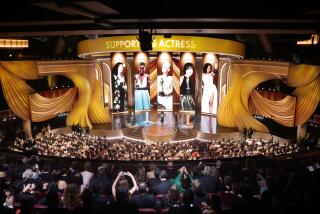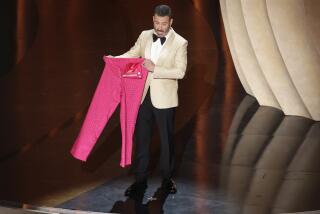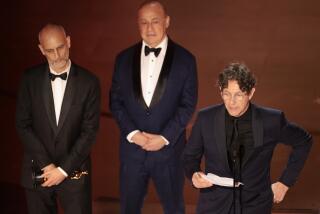Still Fabulous or Now Faded?
Here, in a nutshell, is what Camille Paglia thinks: “Oscar night was a huge, ecstatic event for me from childhood to adulthood. But in just the last few years, I’ve begun to lose interest because of the mediocrity of Hollywood movies, the banality of our so-called stars, and the oafish tedium of the awards broadcast itself.”
Paglia is an author, cultural critic, movie buff and columnist for the online magazine salon.com, where she does an annual quick-hit retort to the Oscar broadcast. Last year, though, Paglia says, she gave up watching the awards show and didn’t bother with a full report.
“At midnight I said, ‘The hell with it!’ and went to bed,” she says.
She was responding via e-mail to a yearly question: Do the Oscars still feel like the cultural event of the year or a marathon ode to the cult of celebrity?
As a shared viewing experience, few occasions outside sports merit the collective attention of the Academy Awards, whose 73rd installment will begin at 5:30 p.m. Sunday on ABC. Last year’s telecast, the second-most-watched Oscars in the past five years, drew an estimated 46 million viewers. That doesn’t include global viewers, but in America, it’s worth noting, the viewing audience for the 2000 Oscar telecast trailed by 12 million the audience that watched the last half-hour of the season finale of “Survivor,” which if nothing else suggests that the fate of unknowns on an island was more intriguing to America than the fate of “American Beauty,” last year’s best picture winner.
Grousing about the length of the broadcast is common (attention spans, no doubt, are strained to the breaking point with the presentation of the Irving G. Thalberg Memorial Award). ABC, for its part, will use the 3 1/2 hours to endlessly plug two of its new sitcoms, “My Wife and Kids” and “What About Joan.”
But the laborious nature of the show is dictated in large part by the Academy of Motion Picture Arts and Sciences, whose parliamentary procedure still must be adhered to; TV exists for the Academy Awards, in other words, not the other way around.
And yet, complaining about the broadcast is too fun for such details to intrude. In that spirit, The Times sought some pre-Oscar-night feedback from Paglia; Mark Burnett, the British-born creator of TV’s biggest current hit, “Survivor”; and Trey Parker and Matt Stone, the duo behind “South Park,” both the TV series and the 1999 movie, “South Park: Bigger, Longer & Uncut.” A song from that film, “Blame Canada,” was nominated for an Oscar and was performed at the ceremony last year by Robin Williams. Parker and Stone were in the audience. They came dressed in drag.
Camille Paglia
First of all, the awards show should be entirely about movies. The amount of time wasted on juvenile comedy routines by showboating hosts is ridiculous. Just introduce the show and get off the stage! The elimination of dance routines last year was idiotic. Dance is one art form that is still thriving in America. There should be abundant music and dance in an awards show that celebrates movie-making as a performing art. But enough with high-concept sets and special effects that interfere with the talent--or grand staircases that make women tottering on high heels risk life and limb.
The intricate craft of movie-making should be much more stressed in the show. Instead of blinding, incoherent montages of bits from 500 classic films, care should be taken to prepare segments that inform and educate the mass audience about the technical expertise that produces and supports the image on the screen. Presenters should be sternly told to cut the shtick and act dignified and, for heaven’s sake, learn how to say the nominees’ names, particularly the foreign ones. Giggling, flirting and in-jokes at the podium are utterly adolescent and make the U.S. look silly and parochial to the worldwide audience. . . . The major Oscars have been going to B- and even C+ performances, debasing the glorious meaning of the Oscar in the history of the American arts.
Mark Burnett
What makes “Survivor” work each week is seeing who gets voted off [at the end]. I would never think of turning the Oscars off until the end. And yet they’re smart enough to put in big awards early. . . . I wouldn’t redo anything, the suspense is great.
I love the show, I remember watching it growing up my entire life. It’s just the coolest thing. . . .
One thing that’s missing from it [is] commercials. Think of the Super Bowl. . . . What’s great about the Super Bowl is that the commercials are anticipated [as much as the game]. But not on the Oscars. . . .
I’m one of those people who’s completely fascinated. I don’t care who you are, you can’t help staring at major movie stars. It’s our culture. It’s the thing we all love. This is the Academy Awards. It’s awesome.
Trey Parker, Matt Stone
Stone: They should just make it an hour to an hour-and-a-half long. And it would just be awards and acceptance speeches. They wouldn’t give you that [stuff] in between. . . . They have to fill up four hours because they want to sell four hours of ad time. If they want to perform songs or a montage of special effects, that’s OK. But these things like kids and the movies, or [when they say], ‘Movies can make us laugh, and cry.’ It’s so self-congratulatory. It’s supposed to be for the people who have excelled in the industry, not just for the whole industry. And it’s disgusting to be there. It really was.
Parker: That’s why we had to wear dresses. If we had been there in tuxes, and like, “Here we are, we’re a part of this whole thing.” . . . We wanted to go, because, you know, how many times do you get nominated for an Academy Award? But I cannot wear a [expletive] tux and walk into that thing that I just think is the most disgusting part of our country. How can you do that? Still, probably out of everything I’ve done, maybe the movie’s No. 1, but [dressing in drag] is the thing I’m most proud of, No. 2.
Stone: Because people thought that was a publicity stunt. But it wasn’t.
Parker: It was like, “Here’s what I think of your stupid [expletive] awards ceremony.”
Stone: We left. Right after Robin Williams got through singing [“Blame Canada”].
Parker: We left and had dinner.
Stone: The thing they had last year that really [expletive] me off was that history through the movies. Remember that? It started out with a caveman throwing a rock at a dinosaur from some old [movie]. It was like, “Here’s how movies teach history.” But learning history at the movies is something you should be ashamed of. . . .
The reason why it can be four hours is because it has a built-in drama. One, it’s the biggest stars in the world, so that’s a pretty good draw. And two, it has that built-in drama [of] who’s going to win. So it can just be a big, stupid retardo fest.
Parker: In 50 years, I think, it’s going to be looked back on and just laughed at. People are going to say, “Can you believe this is how people really were?” Our grandkids will be like, “What the [expletive]? That’s why I had to wear a dress. Because I couldn’t have my grandkid going, ‘[Granddad], you’re a big [expletive] dork.”
Stone: See, granddad was one of the first ones to know that this was really stupid and lame.
*
Ever wondered what it’s like to attend the Oscars? Take a walk along the path from the red carpet to the press room. F8
TV writer Brian Lowry says anyone who subscribes to the idea that brevity is the soul of wit never tried sitting through a Hollywood awards show. F10
Not everyone takes the Oscars seriously--especially on the Internet. F12
Test your Oscar trivia: Vote in an online poll and catch up on all The Times’ coverage of this year’s Academy Awards at https://www.latimes.com/oscars.
(BEGIN TEXT OF INFOBOX / INFOGRAPHIC)
The Winners’ Walk
The Academy Awards returns Sunday night to the Shrine Auditorium for perhaps the last time. Next year, the annual show moves to its permanent home at a theater now under construction in Hollywood. A behind-the-scenes tour from an Oscar-winner’s point of view:
1. Arrival
Around 5 p.m., limousine traffic fills both sides of Jefferson.
180 valets await 1,200 limousines.
Boom camera captures limo arrivals.
2. Red Carpet
Stars walk a gauntlet of media and fans.
Up to 750 fans camp overnight to fill bleachers lining promenade. Up to 500 uniformed and plain-clothed security on hand.
Fans enter through metal detector.
Award show regulars like Daily Variety’s Army Archerd seek interviews.
3. Auditorium
The Shrine features a Moorish-style facade with cupolas, arched entryways.
5,450 Academy members attend 3-hour show; non-celbrities sit in balcony.
180 seat-fillers in formal wear wait in the wings to temporarily sit in the starts’ seats when celebrities take stage.
Nominees and presenters sit in first 30 rows.
4. On Stage
Curved cove, Oscar cutouts form stage backdrop.
Winners get 45 seconds for acceptance speech before orchestra is cued.
Presenters read from a TelePrompTer that displays 4-inch letters on a big screen TV that is 75 feet from stage.
5. Press Tent
Winners and presenters meet the media after leaving stage, then return to auditorium.
Reporters raise paddles to ask questions.
Motorcycle messengers deliver film, video to newsrooms.
6. Banquet Hall
Nominees, presenters stop first at Governors Ball before hitting post-Oscar party circuit.
Chef Wolfgang Puck and staff prepare multi-course meal in two field kitchens.
Refrigerated truck stores food.
(BEGIN TEXT OF INFOBOX / INFOGRAPHIC)
Meet Oscar
Legend has it that in 1931, Academy employee Margaret Herrick remarked that the statuette resembled her Uncle Oscar. The name was officially adopted in 1939.
Official name: Academy Award of Merit.
Depiction: Knight holding a crusader’s sword standing on a film reel.
Number presented: 2,365
Height: 13 1/2 inches.
Weight: 8 1/2 pounds.
Materials: Pewter alloy plated in copper, nickel, silver and 24-karat gold, epoxy coated.
Designer: MGM art director Cedric Gibbons, sketched on a tablecloth in 1927.
Sources: Academy of Motion Picture Arts and Sciences, L.A. Department of Building and Safety, Telescript, Times reports.
Graphics reporting by Brady McDonald, Los Angeles Times
(BEGIN TEXT OF INFOBOX / INFOGRAPHIC)
Oscars Through The Years
Highlights from Academy Awards shows at the Shrine:
19th Show, March 13, 1947
* Academy changes voting rules, allowing only members to select nominees and winners. Membership swells from 700 to 1,675.
* With larger venue, general public can buy tickets to awards show for first time.
* “The Best Years of Our Lives” picks up seven awards, including best picture, actor (Fredric March), director (William Wyler) and supporting actor (Harold Russell). Russell also picks up a special Academy Award.
* The evening opened with then-Screen Actors Guild President Ronald Reagan onstage narrating a silent compilation of previous Oscar-winning films. However, there was a problem in the projection booth, and the film was shown upside down, backward and even on the ceiling.
20th Show, March 20, 1948
* Two films each win three awards. “Gentleman’s Agreement” takes best picture, supporting actress (Celeste Holm) and director (Elia Kazan), and “Miracle on 34th Street” wins best supporting actor (Edmund Gwenn) and two writing awards -- original story and screenplay.
* Celeste Holm was in the audience, knitting, when her name was called. Years later she said: “I dropped the ball of yarn, and it rolled underneath the seats.”
* Daily Variety’s annual straw poll misses wildly in the best actress category with dark horse Loretta Young taking the statuette for “The Farmer’s Daughter.” The straw-poll tradition ends the next year, when the academy asks members to remain mum.
* The academy honors a foreign film for the first time when it bestows a special award on Italy’s “Shoeshine.”
60th Show, April 11, 1988
* “The Last Emperor” goes nine for nine, winning every prize for which it’s nominated, including best picture and director (Bernardo Bertolucci).
* Talk centers on a massive traffic jam that snarls streets and freeways around the Shrine, forcing celebrities to abandon their limos and sprint to the show in their tuxedos and gowns. The jam forces producers to scratch an elaborate segment of the show.
* Host Chevy Chase greets the crowd with a cheery “Good evening, Hollywood phonies.”
* Heated writers’ strike overshadows the show.
61st Show, March 29, 1989
* “Rain Man” leads with wins for best picture, actor (Dustin Hoffman), director (Barry Levinson) and original screenplay (Ronald Bass and Barry Morrow).
* Sigourney Weaver loses twice despite two nominations - best actress for “Gorillas in the Mist” and supporting actress for “Working Girl.”
* Disney threatens to sue the academy over opening sequence featuring an undignified Snow White singing and dancing with Rob Lowe.
63rd Show, March 25, 1991
* With 12 nominations, “Dances With Wolves” wins seven awards, including best picture, director (Kevin Costner) and adapted screenplay (Michael Blake).
* Madonna, in full Marilyn Monroe mode, causes a buzz by arriving on the arm of Michael Jackson.
* Host Billy Crystal makes his entrance via horseback - shamelessly plugging the upcoming “City Slickers.”
67th Show, March 27, 1995
* Tom Hanks wins back-to-back best actor Oscars, following up the previous year’s award-winning “Philadelphia” performance with an award for “Forrest Gump.”
* “Gump” takes a total of six statuettes, including best picture, director (Robert Zemeckis) and adapted screenplay (Eric Roth).
* Post-show talk centers on best costume design winner Lizzy Gardiner’s (“The Adventures of Priscilla, Queen of the Desert”) American Express Gold Card dress.
69th Show, March 24, 1997
* Independent studios sweep the major prizes.
* “The English Patient” wins nine awards, including best picture, director (Anthony Minghella) and supporting actress (Juliette Binoche).
* To enormous applause, boxer Muhammad Ali takes the stage when “When We Were Kings” wins best feature documentary.
70th Show, March 23, 1998
* “Titanic” sinks the competition, tying 1959’s “Ben-Hur” as the winningest Oscar film of all time with 11 statuettes, including best picture and director (James Cameron).
* For the seventh time in academy history, best actor and actress winners come from the same movie - Jack Nicholson and Helen Hunt in “As Good as It Gets.”
* Best supporting actress Kim Basinger (“L.A. Confidential”) wins for a role she nearly turned down, and Robin Williams earns best supporting actor for his role in “Good Will Hunting.”
72nd Show, March 25, 2000
* “American Beauty” takes home five awards, including best picture, actor (Kevin Spacey) and director (Sam Mendes).
* “South Park” creator Trey Parker shows up on the red carpet in a version of Jennifer Lopez’s emerald-green, low-cut/high-cut dress, while cohort Matt Stone dons a knockoff of the pink gown Gwyneth Paltrow wore at the 1999 Oscars.
* Host Billy Crystal incorporates the year’s academy miscues, ranging from lost ballots to stolen statuettes, into his opening monologue.
Sources: “70 Years of the Oscar” by Robert Osborne, Times reports
Graphics reporting by Brady McDonald and Susan King, Los Angeles Times
More to Read
The biggest entertainment stories
Get our big stories about Hollywood, film, television, music, arts, culture and more right in your inbox as soon as they publish.
You may occasionally receive promotional content from the Los Angeles Times.










